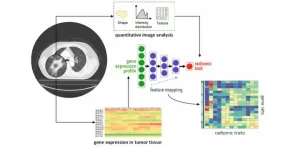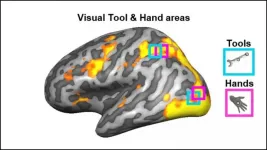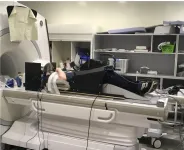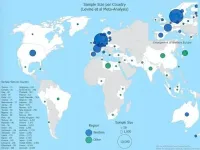In The Journal of Wildlife Management, researchers reported findings from a nationwide survey of college students' interest and participation in hunting. They found current, active hunters were more likely to be white, male and from rural areas, and to have family members who hunted. But they also found a group of potential hunters - with no hunting experience but an interest in trying it - who were more diverse in terms of gender, race and ethnicity.
"There are a lot of potential hunters out there who look nothing like current hunters, suggesting there are many different pathways into hunting," said study co-author Lincoln Larson, associate professor of parks, recreation and tourism management at NC State. "We are working to find messages and strategies that resonate with new and diverse groups."
In the study, researchers surveyed 17,203 undergraduates at public universities in 22 states from 2018 to 2020 to understand college students' perspectives on hunting. Recruiting new hunters has become a priority for state wildlife agencies as declines in hunting participation have also meant a reduction in a vital source of funding for agencies' operations: revenue from hunting licenses and excise taxes on hunting gear and ammunition.
"For nearly 100 years, hunting and angling have combined to provide a majority of wildlife conservation funding in the United States," Larson said. "Without people participating in these activities, our current conservation model won't work. By helping college students connect with public lands and wildlife, we can create a more sustainable source of funding into the future."
They found 29 percent of all students in the survey had hunted at some point in the past, and another 11 percent had accompanied a hunter in the field. The biggest predictor of whether a student hunted was having an immediate family member who also hunts.
When they sorted students into categories of active, potential, lapsed and non-hunters, they found approximately 26 percent of students were active hunters. They were 84 percent white, 74 percent male, and many were from rural hometowns. In addition, most active hunters had immediate family members who also hunted, and just 7 percent reported no social support for hunting.
In comparison, the largest group of college students were non-hunters, at 50 percent. The smallest group, at 3 percent, were lapsed hunters. Twenty-two percent of students were potential hunters, which meant they said they might try it once, or they might hunt rarely or regularly in the future.
Potential hunters were a more diverse group compared to active hunters. Forty-seven percent were female, and 38 percent identified as either Black or African-American, Hispanic or Latinx, Asian, American Indian or other.
Forty-three percent of potential hunters were from urban hometowns, and 74 percent did not have immediate family members who hunt. Seventy-nine percent were majoring in fields outside of agriculture or natural resources.
"We found many potential hunters who don't share the same attributes as active hunters," Larson said. "What's motivating them, what's limiting their participation and how do we build a bridge to help connect them to hunting and wildlife conservation?"
For students across the survey, getting ethically and locally sourced meat was the biggest motivator for hunting. Students across all groups also supported hunting as a conservation tool. Hunting for social reasons or for sport were more prominent motivations among active hunters. The biggest constraints they found among non-hunters, potential hunters and lapsed hunters was interest in other activities.
"One of our biggest takeaways is that many students, regardless of their background, support ecological conservation motivations for hunting. They care about controlling over-populated species and about improving personal and environmental health by eating local game meat," said the study's lead author Victoria Vayer, a former graduate student in parks, recreation and tourism management at NC State. "If we use messaging that relates to those motivations, instead of emphasizing contentious things like trophy hunting, we could reel in more potential hunters without eroding support among people who don't hunt."
INFORMATION:
The study, "Diverse University Students Across the United States Reveal Promising Pathways to Hunter Recruitment and Retention," was published online in The Journal of Wildlife Management. The study was funded by the Association of Fish and Wildlife Agencies' Multistate Conservation Grant Program, through U.S. Fish and Wildlife Service Awards F18AP00171 and F19AP00094.
Note to editors: The abstract of the paper follows.
"Diverse University Students Across the United States Reveal Promising Pathways to Hunter Recruitment and Retention."
DOI: https://doi.org/10.1002/jwmg.22055
Published online in The Journal of Wildlife Management May 6, 2021.
Authors: Victoria Vayer, Lincoln Larson, M. Nils Peterson, Kangjae Jerry Lee, Richard Von Furstenberg, Daniel Y. Choi, Kathryn Stevenson, Adam A. Ahlers, Christine Anhalt-Depies, Taniya Bethke, Jeremy Bruskotter, Chris Chizinski, Brian Clark, Ashley A. Dayer, Benjamin Ghasemi, Larry Gigliotti, Alan Graefe, Kris Irwin, Samuel J. Keith, Matt Kelly, Gerard Kyle, Elizabeth Metcalf, Wayde Morse, Mark D. Needham, Neelam Poudyal, Michael Quartuch, Shari Rodriguez, Chelsie Romulo, Ryan L. Sharp, William Siemer, Matt Springer, Richard Stedman, Taylor Stein, Tim Van Deelen and Jason Whiting.
Abstract: Declining participation in hunting, especially among young adult hunters, affects the ability of state and federal agencies to achieve goals for wildlife management and decreases revenue for conservation. For wildlife agencies hoping to engage diverse audiences in hunter recruitment, retention, and reactivation (R3) efforts, university settings provide unique advantages: they contain millions of young adults who are developmentally primed to explore new activities, and they cultivate a social atmosphere where new identities can flourish. From 2018 to 2020, we surveyed 17,203 undergraduate students at public universities across 22 states in the United States to explore R3 potential on college campuses and assess key demographic, social, and cognitive correlates of past and intended future hunting behavior. After weighting to account for demographic differences between our sample and the larger student population, we found 29% of students across all states had hunted in the past. Students with previous hunting experience were likely to be white, male, from rural areas or hunting families, and pursuing degrees related to natural resources. When we grouped students into 1 of 4 categories with respect to hunting (i.e., non?hunters [50%], potential hunters [22%], active hunters [26%], and lapsed hunters [3%]), comparisons revealed differences based on demographic attributes, beliefs, attitudes, and behaviors. Compared to active hunters, potential hunters were more likely to be females or racial and ethnic minorities, and less likely to experience social support for hunting. Potential hunters valued game meat and altruistic reasons for hunting, but they faced unique constraints due to lack of hunting knowledge and skills. Findings provide insights for marketing and programming designed to achieve R3 objectives with a focus on university students.







